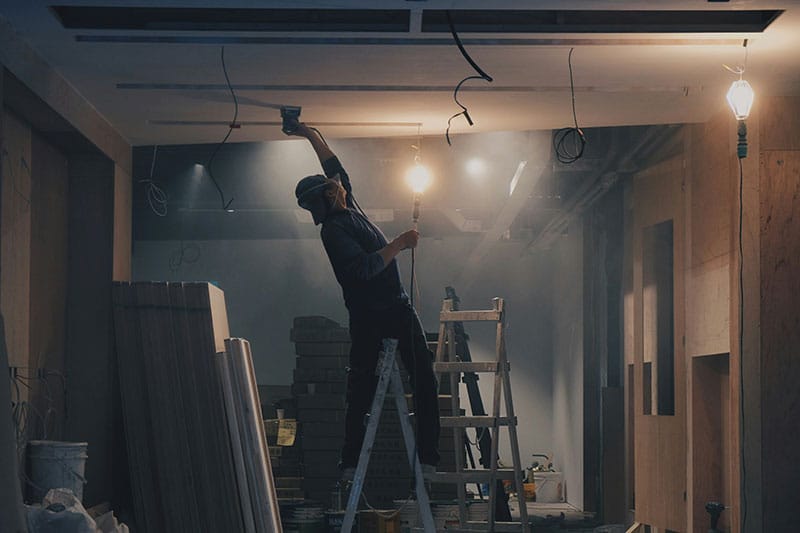What types of asbestos testing are mandatory during property renovations in the UK?
Despite being banned in all its forms in late 1999, the story of asbestos in the UK did not end at the conclusion of the 20th century. Indeed, the outlawing of this notoriously dangerous substance did not include an automatic requirement for asbestos-containing materials (ACMs) to be removed from UK buildings in which they were already present.
This means that if you own, or otherwise manage or maintain, a property in the UK that dates to before the year 2000, there will be a strong likelihood of ACMs – such as asbestos insulating board (AIB), textured decorative coatings, or loose asbestos cavity insulation – still being inside. This, in turn, could bring great risks to health if those ACMs are disturbed during a renovation project.
In light of this, it should be no surprise that stringent regulations exist in the UK with regard to asbestos management – including when it comes to testing.
This article will outline the mandatory asbestos testing required for properties built before the year 2000, when the fibrous silicate mineral was still in legal use in the UK. In addition, we will explore the other vital things for you to know about asbestos testing.

What is meant by ‘asbestos testing’ during property renovations?
If you intend to renovate your property – whether it is a residential, commercial, industrial, or public building – and you have never arranged asbestos testing in the past, you might not know the exact distinction between “asbestos testing” and “asbestos surveying”.
So, here is a quick summary of the differences:
- An asbestos survey entails a qualified surveyor inspecting a building to identify and record ACMs. Three types of asbestos survey exist in the UK: a management survey and a refurbishment survey and a demolition survey (which we will elaborate on in a shortly).
- Asbestos material testing takes, as its starting point, one or multiple specific samples of potential ACMs that have been captured from a building (for example, a section of a textured decorative wall, if it is suspected that this material might be asbestos-containing Artex). This sample is then analysed in a laboratory, to confirm whether it contains asbestos fibres.
It is crucial to understand the distinctions between these two services, given the profound implications this can have for safety and compliance.
Let’s imagine, for example, that you are a “dutyholder” for a non-domestic premises in accordance with Regulation 4 of the Control of Asbestos Regulations 2012 (CAR 2012) – the overarching asbestos legislation in Great Britain. There isn’t any specific material in the building that you know or suspect to be an ACM; however, you do intend to carry out disruptive renovation work at the property.
If the above describes your situation and plans right now, you will need to know what a refurbishment or demolition asbestos survey is, and when it is legally obligatory.
What is the refurbishment and demolition (R&D) survey, and when is it legally required?
Before we go any further, it is important to cycle back to the aforementioned Regulation 4 of CAR 2012. This part of the landmark legislation stipulates certain responsibilities for people and organisations that are classed as “dutyholders” for a particular property.
You may be a dutyholder for a certain non-domestic premises if, for instance, you are:
- The owner of the building
- The manager of the building
- The person with clear responsibility for the building’s maintenance and repair.
Under CAR 2012, dutyholders are obliged to identify the location and condition of any asbestos-containing materials at their site. Moreover, they are required to manage the risk that any such ACMs pose, in order to prevent harm to occupants or users of the premises.
If you intend to carry out major refurbishment or demolition of your building, it will be a legal requirement for all ACMs to be removed, as far as reasonably practicable, before such disruptive work takes place.
This brings us onto the subject of a refurbishment or demolition survey. These types of survey seek to identify even ACMs that may be hidden deep within the fabric of the given building.
In accordance with this, an R&D survey is the most destructive and intrusive of the asbestos survey types. Having such an inspection carried out, then, allows for all ACMs to be removed from the property – where required – before renovation work begins.
What are the standard methods used in mandatory asbestos testing?
The exact methods used for asbestos testing ahead of, during, and even after a property renovation will depend on the exact form of “asbestos testing” that is undertaken:
- Asbestos surveying
As we touched on above, some people might interpret “asbestos testing” as meaning asbestos surveying.
Presuming an R&D survey is requested prior to a renovation project, this will entail destructive inspection, aimed at locating and describing all ACMs in the area where the renovation work will take place. Such a survey will typically involve opening up walls, floors, and ceilings.
- Asbestos sample testing
Even in situations where a complete asbestos survey is carried out before renovation work commences, the only way to confirm whether a suspect material contains asbestos fibres, is to obtain and analyse a sample of it.
Asbestos sample testing, then, can take place as part of a broader asbestos survey of a building, as well as in isolation. This may involve, for example, hand tools being used to capture a small sample of suspected ACMs, before the sample is placed into a double sealable sandwich-type bag, and sent off to a specialist laboratory for the material to be tested.
Polarised light microscopy (PLM) is a commonly used method for the identification of asbestos in bulk samples of building materials. This involves the use of a special microscope to examine asbestos fibres. Crucially, this method is able to distinguish between the chrysotile, amosite, and crocidolite types of asbestos, on the basis of their optical properties.
- Asbestos air testing
There are various circumstances in which you might seek to have asbestos air testing (also sometimes referred to as “asbestos air monitoring”) carried out before, during, or after a renovation project at your building.
You may, for instance, arrange for this process to be undertaken after renovation work has been carried out, at a location where you know ACMs are present. Alternatively, you might already be aware of certain damaged ACMs at your site. This may lead to your use of asbestos air testing to determine to what extent loose asbestos fibres might be present in the air.
Asbestos air testing basically works as follows: qualified analysts use specialised equipment to capture air samples, which are then analysed under a microscope.
A standard technique used to perform this analysis, is phase contrast microscopy (PCM). As we have previously written about, PCM analysis is a quick and cost-effective means of identifying fibre concentrations in the air. This allows it to make a significant contribution to asbestos safety at a site where renovation work may be undertaken.
What mandatory asbestos testing must occur after renovation or asbestos removal?
In the vast majority of situations where licensed asbestos removal work is carried out, a four-stage clearance process will need to be followed.
This process will allow for impartial, expert confirmation of asbestos within an enclosure having been removed or remediated to the agreed scope, as well as that the given area can be safely reoccupied.
The successful completion of the four-stage clearance process will lead to a ‘certificate of reoccupation’ being issued.
The four stages in question are:
- A preliminary site check, looking at such aspects as where the asbestos was removed from, what asbestos materials were removed, and an initial impression of job completeness.
- A visual inspection of the asbestos enclosure or work area. This is the most important of the four stages; it entails the asbestos analyst checking the completeness of the removal of the asbestos materials from all surfaces.
- PCM air monitoring, including dust disturbance to replicate any occupational activities that could conceivably take place in the area in future.
- Final clearance certification. Following the removal of the asbestos enclosure, the asbestos analyst will undertake a further visual inspection of the area to ensure its cleanliness. If they are satisfied that the necessary standards have been met, the ‘certificate of reoccupation’ can then be issued.
Who is qualified to carry out mandatory asbestos testing in the UK?
Individuals or organisations that conduct asbestos testing and/or surveying in the UK will need to meet certain competency and accreditation standards, as set out by CAR 2012.
Remember: as a dutyholder for a particular building that you are seeking to renovate, it is in your own interests – from a quality, safety, and compliance perspective – to only use suitably accredited and certified asbestos surveyors and analysts.
The Oracle Solutions team has written in the past about the skills and qualifications that an asbestos surveyor should have.
Relevant qualifications include the likes of the Royal Society for Public Health (RSPH)’s Level 3 Award in Asbestos Surveying, and the British Occupational Hygiene Society (BOHS)’s P402 qualification in relation to Surveying and Sampling Strategies for Asbestos in Buildings.
What are the consequences of failing to comply with mandatory asbestos testing requirements?
In addition to potentially risking the health of anyone who occupies, visits, and/or uses your property both now and in the future, failing to adhere to the requirements for mandatory asbestos testing in the UK could lead to legal and financial penalties.
Serious breaches of the asbestos regulations can lead to unlimited fines, and/or imprisonment for as long as two years.
Final Thoughts
If you intend to oversee renovation work at your property, it will be of critical importance to familiarise yourself with the relevant rules for asbestos testing, and to ensure your compliance with them. Otherwise, there could be major health, legal, and/or financial implications.
Contact Oracle Solutions today, to learn more about how proactive management and consultation with qualified professionals can help keep you on the right side of the UK’s strict asbestos legislation, as part of a successful renovation project.

Written by Brendan Coleman
Brendan Coleman, with decades of experience in the asbestos industry, is a dedicated Quality Manager. Certified as a surveyor and analyst, he is adept in operations and quality management with a keen focus on HSE compliance. His expertise is pivotal in maintaining high safety and efficiency standards. Brendan ensures our UKAS accreditation requirements are consistently met and exceeded, upholding stringent standards in asbestos remediation. His commitment to enhancing quality and customer satisfaction makes him an essential advisor in asbestos management.
